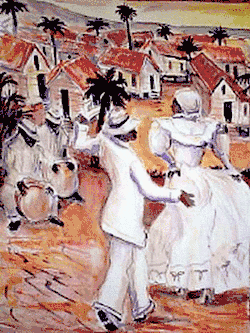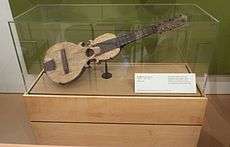Plena
La plena is a genre of music and dance native to Puerto Rico.[1][2]
| La Bomba | |
|---|---|
 Dancing Bomba and Plena | |
| Stylistic origins | Caribbean |
| Cultural origins | Puerto Rico |
| Typical instruments | Originally: pandero, guitar, accordion, vocals More recently added: güícharo, cuatro, bass, trombone, sax |
| Other topics | |
| Music of Puerto Rico | |
| Music of Puerto Rico | |
|---|---|
 A (c. 1900 - 1915) Puerto Rican Cuatro | |
| General topics | |
| Related articles | |
| Genres | |
| Nationalistic and patriotic songs | |
| National anthem | La Borinqueña |
| Regional music | |
| |
Origins
The plena genre originated in Ponce around 1900.[3] It was influenced by the bomba style of music. It was first heard in the neighborhood Barriada de la Torre or as Jose Rosa in his World Music Survey: The Music from Latin America and the United States states, in the Barrio de San Anton (in Ponce).[4] Originally, sung texts were not associated with the plena, which was rendered by guitar, accordion and pandero, but eventually, in 1907, singing was added.
Plena was often called the periodico cantado or "sung newspaper" for the lower classes because it spread messages among people, similar to the corridos in Mexico. The traditional center of plena was San Antón, a barrio of Ponce.[5]
History
The plena was a result of the mixing of the culturally diverse popular class, where their workplace, neighborhood, and life experiences met to create an expressive, satirical style of music.[6] It became a way for the working class to gain empowerment through parody. Due to its lower class origins, it was regarded by the upper class as "a menace to public order and private property" and was for many years associated with people of la vida alegre (the merry life), referring to prostitutes, dancers, alcoholics, and moral degenerates. Singing and dancing of the plena often happened in cafetines, bars that frequently doubled as brothels and where interracial socializing and sexual encounters were free to take place.[7]
According to singers discussing the use of the plena, they stated it was song with lyrics that related to a current event. For example, if someone drowned or was killed, a plena would be written about it.[8] Tintorera del Mar,[9] Mataron a Elena, El Obispo de Ponce, and Matan a Bumbum[10] were some plenas which became wildly popular.[11]
The eventual widespread acceptance of the plena can be attributed to the increased number of people joining the workforce, which led to a new demand for public leisure. It was still considered indecent by the upper class, who fought against its rising popularity. In December 1917, an ordinance was passed banning the dances from happening inside the city limits. It took another decade for the plena to gain widespread popularity throughout Puerto Rico and cross racial and cultural boundaries. Listening to plena at home and at neighborhood- or municipal-sanctioned celebrations became acceptable and was no longer considered morally tainted by "respectable" white upper class Ponceños. Eventually, with much whitewashing to make it more palatable to the masses, plena was embraced in earnest as a style of music that united Puerto Ricans. However, with the acceptance of the upper class, what began as vitally important cultural identifier and personal expression of philosophy, community, and self to the lower class became an entertaining spectacle for the white upper class.[7]
By the 1930s, the plena was accessible to all through the radio and record industries.[7]
Genre
Plena music is generally folkloric in nature. The music's beat and rhythm are usually played using hand drums called panderetas, also known as panderos. The music is accompanied by a scrape gourd, the guiro. Panderetas resemble tambourines but without the jingles. These are handheld drums with stretched animal skins, usually goat skin, covering a round wooden frame. Three different sizes of pandereta are used in plena: the Seguidor (the largest of the three), the Punteador (the medium-sized drum), and the requinto. An advantage of this percussion arrangement is its portability, contributing to the plena's spontaneous appearance at social gatherings. Other instruments commonly heard in plena music are the cuatro, the maracas, and accordions.[12]
The fundamental melody of the plena, as in all regional Puerto Rican music, has a decided Spanish strain; it is marked in the resemblance between the plena Santa María and a song composed in the Middle Ages by Alfonso the Wise, King of Spain. The lyrics of plena songs are usually octosyllabic and assonant. Following the universal custom the theme touches upon all phases of life—romance, politics, and current events. Generally, anything which appeals to the imagination of the people, such as the arrival of a personage, a crime, a bank moratorium, or a hurricane, can be the subject of plena music.
Spread
Plena is played throughout Puerto Rico especially during special occasions such as the Christmas season, and as the musical backdrop for civic protests, due to its traditional use as a vehicle for social commentary. When plena is played the audience often joins in the singing, clapping, and dancing.
Composers
As a folk genre, there have been many good composers, some well known in their day and into the present. Perhaps one of the genre's most celebrated composers and performers was Manuel Jiménez, known as 'El Canario'. Certainly, there were many others, including such greats as Ramito, Ismael Rivera, Mon Rivera (the junior), and Rafael Cortijo. The genre has had a revival recently, as evident by the emergence of many plena bands (such as Plena Libre, Atabal, and Viento de agua) and its use in various songs, such as Ricky Martin's recent song "Pégate" and Ivy Queen's "Vamos A Celebrar".
References
- Todo listo en Ponce para recibir a Cheo Feliciano. Inter News Service. 20 April 2014.
- Welcome to Puerto Rico: Music - see La Bomba
- La Plena: Nació en Barrio San Antón. El Mundo, 23 November 1971. page 23.
- The Garland Encyclopedia of World Music. Taylor & Francis. 2000. p. 939. ISBN 0-8240-4946-2.
- LEY: Para reconocer al Barrio San Antón, del Municipio de Ponce, como lugar de interés histórico y cultural, y designarlo como “Cuna de la Plena”, y para disponer para la coordinación entre el Instituto de Cultura Puertorriqueña y el Municipio de Ponce para implementar lo dispuesto en esta Ley, y para la promoción de los valores históricos y culturales de esta comunidad. Archived 28 January 2017 at the Wayback Machine Estado Libre Asociado de Puerto Rico. 16ta. Asamblea 1ra. Sesión. Legislativa Ordinaria. Camara de Representatntes. Projecto de la Camara Numero 1392. 24 March 2009. Accessed 1 April 2018.
- Modak, Sebastian (15 February 2019). "Visiting Puerto Rico, and Finding the Up Beat". NYT.
- Honor, status, and law in modern Latin America. Caulfield, Sueann., Chambers, Sarah C., 1963-, Putnam, Lara. Durham: Duke University Press. 2005. ISBN 0822335751. OCLC 57311296.CS1 maint: others (link)
- "Centro: Sound: Interview Two with Ovidio Dávila on December 18 1992 [RGC.ODav.1992.12.18.2]". centropr.hunter.cuny.edu.
- Aparicio, F.R. (2010). Listening to Salsa: Gender, Latin Popular Music, and Puerto Rican Cultures. Music Culture. Wesleyan University Press. p. 32. ISBN 978-0-8195-6994-3. Retrieved 20 October 2019.
- Roy-Féquière, M. (2004). Women, Creole Identity, and Intellectual Life in Early Twentieth-century Puerto Rico. Puerto Rican studies. Temple University Press. p. 119. ISBN 978-1-59213-231-7. Retrieved 20 October 2019.
- Pfeiffenberger, Sylvia (10 February 2010). "Jazz finally taps into plena, one of Puerto Rico's overlooked rhythms". INDY Week. Retrieved 20 October 2019.
- "Bomba and Plena Artists Offer Live Music in Puerto Rico". La Salita Cafe. Archived from the original on 25 June 2014. Retrieved 28 June 2014.
- Aparicio, Frances R., "Listening to salsa: gender, Latin popular music, and Puerto Rican cultures", Wesleyan University Press, 1998. ISBN 978-0-8195-6308-8. Cf. Chapter Two: A Sensual Mulatta Called the Plena, pp. 27–44.